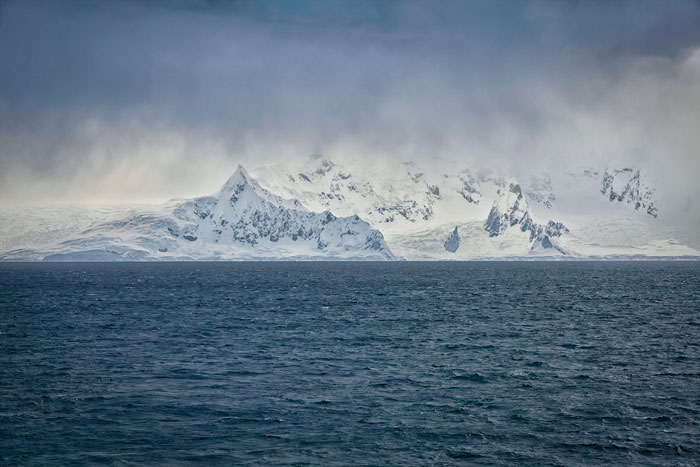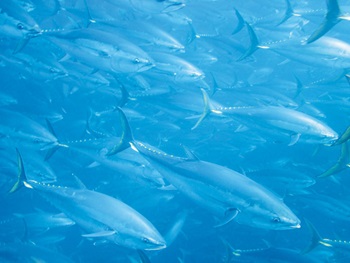While humans harness sound to navigate the ocean and its riches, there are growing concerns about the potential impact of industrial noise pollution on marine ecosystems
 Photo: Photolibrary.com
Photo: Photolibrary.com By Bianca Nogrady
It is easy to think of the ocean as a place of deep blue quiet, especially in comparison to the hectic and noisy modern city environment. But the reality is quite the opposite – our seas and oceans abound with sound: the clicks of fish and animals echolocating, the hollow booms and high-pitched whistles of whalesong, the crashing of waves, and even the distant cracking of southern ice floes.
In a world where vision is often compromised by poor light and distance, sound is essential for communication. Fish and other marine creatures all use noise to communicate, to find mates, to detect predators and to navigate around their environment.
But sound is also an essential tool for a host of industries, including the fishing, oil and gas industries. The fishing industry uses noise to navigate, to find fish, and to warn other creatures away from its catch and equipment. The oil and gas industry uses sound to find mineral deposits deep under the ocean floor; and the mining process itself can be noisy.
Noise is also an inevitable byproduct of boats and shipping. As the commercial and recreational use of marine vehicles increases, so too will noise pollution from engines and equipment.
As the competition for underwater bandwidth has increased, marine noise pollution is becoming a major concern, and evidence is building about potential long-term and far-reaching consequences that could affect life underwater, and those industries that rely on marine life for their livelihoods.
Industries with a stake in the issue are now initiating significant research, in an attempt to tease apart incredibly complex interactions, and to work out exactly if, and how, noise pollution is affecting marine life.
Research limits
The limited research that has been completed to date in Australia tends to involve small-scale, close-quarter experiments that reveal little about the wider population-level effects. Few studies have been done in the Australian environment with Australian species.
“We’re not entirely sure how serious an issue it is, in that there’s been so little measurement of it,” says Geoff McPherson, marine fisheries and acoustic consultant for Marine Acoustic Biodiversity Solutions, and adjunct principal research fellow at James Cook University.
“Most of the available research involves playback experiments of ship noise and while there’s bona fide criticism of that methodology from a physics point of view, that sort of information is showing that there is an effect,” he says.
In Australia, seismic surveys conducted for oil and gas exploration are becoming the leading concern. A ship tows an array of air guns that discharge high-pressure air into the water every few seconds while crisscrossing the oceanic survey area.
Long strands of acoustic receivers record the reflected pressure waves from the sea floor. The recorded data is then analysed to build up a picture of rock layers below the seabed and to reveal any potential oil or gas reservoirs.
A Canadian report, Effects of Seismic Energy on Fish1, identified that adult fish within five metres of the air gun can suffer damage to their swim bladders and ear cells, internal bleeding, and blindness. Other evidence suggested ear damage may not repair for weeks to months after the initial exposure.
The bigger question is how these seismic surveys impact fish populations that experience less intense exposure. Unfortunately, these sorts of studies are much harder to do says Christine Erbe, director of the Centre for Marine Science and Technology at Curtin University.
Marine chatter
“Population-level effects, cumulative effects from multiple exposures and long-term effects are extremely difficult to measure and tease out,” she says.
“Also, the ocean is naturally very noisy, so we record ice cracking from Antarctica, another impulsive sound, on hydrophones around the southern coast of Australia, several thousand miles away. Animals obviously cope with this natural noise but when it comes to adding industrial noise, the key question is, how much is too much?”
In the wild – as opposed to a tank-based experiment where environmental variables can be controlled – it can be difficult to know if a change in fish or school behaviour is the result of exposure to a specific noise, such as an air gun, or simply the result of fish responding to some other influence, such as a natural noise, a nearby predator or a smell.
And even if the experiment does manage to link the behaviour with the noise, Christine Erbe says the question still remains about the implications of that change in behaviour. Even if behavior changes for an hour after impact, it is unclear whether this would have any impact on the long-term survival of an individual fish, let alone a larger fish population.
The challenge is to clearly demonstrate what impact noise has on fish, and in particular if it is a detrimental one. Anecdotal reports suggest fish respond to noise pollution, but from a policy perspective, anecdotal evidence is not enough.
Geoff McPherson says there are concerns that marine noise pollution could ‘mask’ fish communication and interfere with normal behaviour.
“The best work done to date on tuna was in the Mediterranean, where Italian researchers built a massive cage underwater with tuna in there,” he says. “They had all the ships going past, and they watched the behaviour of oceanic pelagics when impacted by noise, and it disrupted their schooling; it didn’t impact on the animal, it didn’t hurt it, but it reduced the schooling capability.”
Questions unanswered
 Illustration: Paul Dickenson
Illustration: Paul Dickenson The Australian Southern Bluefin Tuna (SBT) industry is exposed to the possible affects of seismic surveys, as many of these are being conducted in the Great Australian Bight off South Australia, which is a key location for tuna migration, says Brian Jeffriess, CEO of the Australian Southern Bluefin Tuna Industry Association.
“The actual fish migrate from the Indian Ocean through the Great Australian Bight and stay there generally for two to three months at a time, and then either go back to the Indian Ocean or go to Tasmania and the east coast of Australia,” Brian Jeffriess says.
CSIRO conducts an annual aerial survey of the tuna in this fishing ground, which is then used to set fishing quotas for that season. For many years, the survey had shown an increase in tuna numbers. The year that a seismic survey was undertaken, the survey also showed a decrease in tuna numbers.
The following year, when there was no seismic testing prior to the CSIRO aerial survey, the numbers returned to the previous growth trend. He says there may have been other variables that caused the 2012 result, but the timing of the seismic surveys did coincide with the drop in numbers. While there is no verified cause and effect between the two events, the industry remains concerned.
Recruitment issues
Johnathon Davey, executive director of Seafood Industry Victoria, says his industry is also concerned about the potential effects of seismic noise on commercial species such as rocklobster, scallops and finfish.
In Victoria, particularly in the Gippsland Basin, the scallop industry is concerned about seismic surveys occurring in areas that have historically been productive scallop grounds. Johnathon Davey says many Victorian scallop fishers believe scallop bed die-offs a couple of years ago may be associated with seismic surveys conducted through Bass Strait in 2009–10.
The Seafood Industry of Victoria has initiated research, through the FRDC, to investigate this issue.
CEO of the South East Trawl Fishing Industry Association, Simon Boag, says the potential effects of repeated seismic surveys in the same areas on fish recruitment has also been raised. He says fishers have reported that fish disappear from an area when seismic testing is being done.
“We know the fish go away. We don’t know what the seismic impulses do, but they certainly move out of the area and it takes some time for them to repopulate.”
Ultimately, with regards to seismic testing, and until we know otherwise, all fish need to be treated with the same level of concern. “When seismic surveys operate, they have to have the marine mammal observers on board,” Simon Boag says.
Former executive officer of the Pearl Producers Association, Brett McCallum, says seismic surveys are also a concern for the pearl industry. Oysters, like scallops, are attached to the sea floor and cannot swim away to escape noise or vibration from seismic or mining activity.
He says while seismic survey companies agree there is a clear need for research to better understand air-gun impact on adult pearl oysters, their larvae cycle and food sources, they have not yet been willing to fund this research.
“The pearl oyster fishery in Western Australia is the last sustainable pearl oyster fishery in the world, and we would like to see the precautionary principle applied, in relation to the potential affects of seismic surveys on the fishery.”
Noise guidelines
While seismic surveys are one of the main concerns in terms of noise pollution in Australian waters, shipping noise is also an issue, particularly in Europe, where underwater noise is now included in any assessment of water quality.
In April 2014, the International Maritime Organization (IMO) released its own guidelines on reducing underwater noise from commercial shipping, due to concerns over the impact on marine life.
In Australia, marine noise pollution is regulated by state environment departments and the National Offshore Petroleum Safety and Environment Management Authority under the auspices of several Acts, including the federal Environment Protection and Biodiversity Conservation Act 1999 (EPBC Act).
There is an EPBC Policy regarding whales and seismic surveys, but no equivalent for fish, despite standards for noise exposure to fish and sea turtles being published in 2014.
There are many existing ways to minimise noise pollution. Geoff McPherson says reducing noise output from boats has the dual benefit of improving efficiency and saving energy, so something as simple as reducing speed when travelling through sensitive areas may save you money and also reduce the impact on marine creatures.
The recent IMO guidelines on underwater noise also suggested a reduction in ship speed to reduce noise. In addition, the guidelines called for propellers to be designed to reduce cavitation – the main source of noise from ships – as well as a focus on hull design to minimise noise, and selection of onboard machinery with appropriate vibration-control measures.
Using sound
 Photo: Courtesy of Dave Ellis
Photo: Courtesy of Dave Ellis Not all man-made sound is problematic for fish or the fishing industry, and indeed sound – in the form of sonar – is an essential part of navigating and locating fish. But sound is also being used to deter interactions between whales and dolphins and fishers or the likelihood that they and other marine creatures will get entangled in lines or nets.
Geoff McPherson says bycatch mitigation alarms, known as pingers, can be attached to nets to warn larger creatures of their presence. “All that is, is a warning device; it’s just a noisemaker, it doesn’t spatially deter the animals, it doesn’t scare them,” he says. “They are making a noise that the animal can hear, which should be within their hearing capability, they’re just a wake-up call so the animal will then be alert.”
But a second application of noise is to more actively deter these same animals from predating fish in nets and on longlines, and here the science is a little more complicated.
Predators such as whales and dolphins use sonar to home in on their targets, so one approach being taken is to try to confuse or block that sonar signal. But it is not as simple as just drowning out the incoming sonar signal.
“No pinger can make more noise than the echoclick of a dolphin, not if it’s battery powered,” Geoff McPherson says. Instead, the industry has been looking at ways of confusing the incoming sonar signal from the animal, using both active and passive acoustic methods.
“With sperm whales, we’re now working on jamming systems so as soon as they click, we click back,” he says. The evidence so far suggests this method is effective with sperm whales, but may not work as well against other predators.
“After four years of working on oceanic longline vessels in projects with Japan’s Fisheries Research Agency, we found that passive acoustic reflector systems were effective but unworkable in many situations,” he says.
However, he says depredation mitigation pingers featuring dolphin sonar activation, and a broad frequency range to prevent dolphins shifting their echo attention around the jamming signal, were associated with significantly better catch returns and profits.
As part of an honours project at the Australian Maritime College, Dean Pease from the Bycatch Program at the Australian Fisheries Management Authority, investigated whether it was possible to mask the echolocation signals from orcas depredating catch such as Blue-eye Trevalla from an auto-longline vessel.
“We looked at what frequency the orcas produced and whether we could replicate their frequency range and use that to mask their own echolocations and basically create enough noise underwater that it became difficult for them to remove fish from the line using echolocation,” Dean Pease says.The pingers used in the trial were not effective, he says.
“We used pingers to produce a range of sounds within the frequency range of orca echolocations. The orcas responded by altering their echolocation clicks to produce one frequency below and one frequency above the noise range produced by the pingers.”
Dean Pease says the use of acoustics in these settings is still in its infancy, and the technology required to put portable alarms on fishing gear has only really been developed in the past five to 10 years.
1 "Effects of Seismic Energy on Fish: A Literature Review", by T. Worcester
Exploration alternatives
While some are looking for ways to reduce the frequency, or control the timing, of seismic surveys, others are looking at alternative methods of surveying for underwater oil and gas reserves.
According to a workshop report by the German-based environmental foundation Okeanos: “They [seismic surveys] produce more noise than is needed for hydrocarbon exploration, the signal is not very repeatable or controllable, and the frequencies produced are not as low as are sometimes necessary for good penetration of the substrate.”
The workshop committee suggested that the time had come for air guns to give way to more environmentally sensitive and effective alternatives.
These alternatives include: marine vibrators that use lower sound pressure over longer periods of time rather than loud acute bursts; microseismic monitoring (also known as passive seismic), which involves monitoring the small-scale seismic activity, both man-made and natural, and using that to build up a picture of undersea reserves; and fibre-optic sensors.
FRDC Research Codes: 2013-209; 2014-004
More information
Ian Knuckey, 0408 581 599, fishwell@datafast.net.au
Geoff McPherson, 07 40573715, mcpherson.geoff@gmail.com





